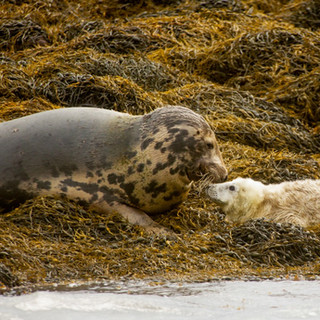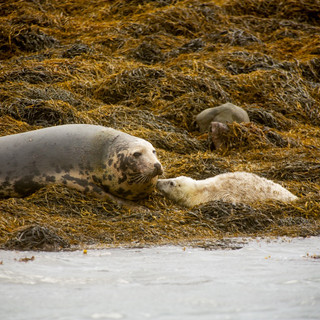
National Trust rangers have completed their annual grey seal and brent geese counts on Strangford Lough
A record number of grey seal pups were counted (190) making Strangford Lough the largest recorded population of grey seals in Northern Ireland
27,390 brent geese were counted indicating the population is stable, but the percentage of juvenile birds within the flock was low at just 2.9 per cent
The entire global population of brent geese is estimated at 30,000 birds with 75-90% travelling to Strangford Lough each autumn
The largest sea lough in the British Isles covering an area of 150 square kilometres, Strangford Lough is one of only three marine nature reserves in the UK and home to over 2,000 species of marine wildlife. A Designated Special Area of Conservation, over a third of the protected area of the lough is managed by the conservation charity National Trust.
Each year, Trust rangers carry out annual sea bird and seal counts as part of their work to monitor wildlife populations and restore and enhance habitats on the lough.
Work has just finished on the light-bellied brent geese and grey seal counts, a process that takes Trust rangers and volunteers many weeks to complete, starting back in July with early seal counts, and finishing on the 15 October with the geese count.

“Our geese count is timed to coincide with the date of the International Brent Census so it’s part of a coordinated count for the species,” explains Hugh Thurgate, Lead Ranger for the National Trust in Strangford.
“By now the majority of birds are in Strangford Lough having completed a 2,500-mile trip from Canada, travelling across Greenland and stopping off briefly in Iceland for a quick refuel, before arriving in Ireland.”
Hugh continues: “Three rangers and three members of the Irish Brent Goose Research Group were stationed around the perimeter of the Lough and counted 27,390 brent geese which is a similar number to the 26,475 recorded last year. The average number since 2002 has been 23,400, so this year ties in nicely with that long-term average.”
The rangers also record the percentage of juvenile birds within the flock. This year the figure was 2.9 per cent. “That’s a relatively low number,” explains Hugh, “but it’s not a disaster. Some years we have had less than one per cent juveniles and on the other extreme, in 2019 it hit a peak of 23.5 per cent. These are long lived birds with a relatively stable population that can wax and wane from year to year.”
This year’s count indicates that the brent geese population is relatively stable, but it wasn’t always the case. The population dipped to below 10,000 in the 1930s when eel grass declined significantly due to a wasting disease and in 2018 a record 38,000 geese were recorded.
“The main thing that impacts on the brent population is their breeding success or otherwise in Northeast Canada,” explains Hugh. “Extreme wet conditions or frozen ground in a delayed spring can result in poor breeding success and low levels of juveniles. If this occurs in a succession of years, the total population size can shrink dramatically. Like many species, the birds are vulnerable to the impact of climate change.”
Hugh continues: “Figures suggest that the geese are quite resilient. But if you consider their entire population is likely to be somewhere around 30,000 birds, as a total species count the figure isn’t that robust.
“Strangford Lough plays a vital role in the survival of the brent geese,” adds Hugh. “It is absolutely critical in terms of providing that essential food when they come in from their long migration and rapidly need to replenish their reserves on the rich eel grass that grows on the mudflats in the lough. It’s quite remarkable to think that somewhere between 75-90 per cent of the entire population of light-bellied brent geese can be found in Strangford during the autumn.”
Eel grass is threatened by the invasive growth of spartina, or common cord grass. In some areas of the lough this grass has taken over, preventing access to the nutrient rich mudflats.
Over the last number of years, NIEA and the National Trust have been actively working to reduce the amount of spartina growth as Hugh explains:
“The Trust recently commissioned a two-year survey of spartina on the lough. This is the first time spartina has been properly mapped and the outcomes will inform our strategy to control spartina in the future. Through careful habitat management we can protect the eel grass. If the eel grass thrives, then the birds will continue to return and refuel on this high protein food source.”

National Trust rangers have also been monitoring grey and harbour seals in the lough since 1993. This work is funded by and undertaken on behalf of, Northern Ireland Environment Agency, who have a statutory obligation to monitor harbour seal numbers as part of their remit for protecting the Strangford Lough Special Area of Conservation, designated as part of the EU’s 1992 Habitats Directive.
Grey seal counts are carried out during July to October to cover pupping and moulting times when the adult population is at its highest. Grey seals can be found in the lough all year round but their numbers surge in September during pupping time when the female seals come into the lough seeking security and shelter on the lough’s many islands.
Data collected by the National Trust reveals a progressive long-term increase in the number of grey seals. In the early 90s there were on average 6-7 pups born each year, ten years later it was about 30 pups, another ten years on it was closer to the 50 mark and in 2017, 150 pups were recorded.
Hugh comments: “This year we counted a record 190 pups and a peak adult population of 235. I think it’s highly likely that we’ll pass the 200-pup mark next year.”
The increase in population mirrors increases throughout the UK. Hugh believes the Scottish grey seal population is beginning to reach saturation point and is pushing down into Northern Irish waters, the Copeland islands for example also seeing grey seal populations on the increase.

With close to 200 pups being born annually, Strangford Lough boasts the biggest recorded breeding population of grey seals in Northern Ireland, but Hugh worries that the increase in recreational water sports on the lough could put the population at risk:
“Seal and seabird disturbance is the hot topic of the moment. We have seen a massive increase in water sports which is something that the Trust, Strangford Lough and Lecale Partnership and NIEA are monitoring. While out doing counts this year, I saw paddle boarders and kayakers very close to seal pupping areas, something I’d never seen historically. The growth in recreational sports, especially those sports where you can approach and land on beaches and islands, poses a real risk to seals and ground nesting birds during breeding season. There’s work to do to educate outdoor activity leaders about wildlife disturbance, to ensure they are aware of the risks and understand what areas of the lough to avoid during breeding season.”
Despite challenges faced from climate change, invasive specifies, people and dogs, it seems the geese and grey seals in the lough are continuing to thrive. “Nature shows incredible resilience in the face of adversity,” adds Hugh. “As a conservation charity, we will continue to care for the lough to ensure it’s here for nature and people to enjoy long into the future.”

To find out more about the work the National Trust does to protect Strangford Lough visit www.nationaltrust.org.uk/strangford-lough


















